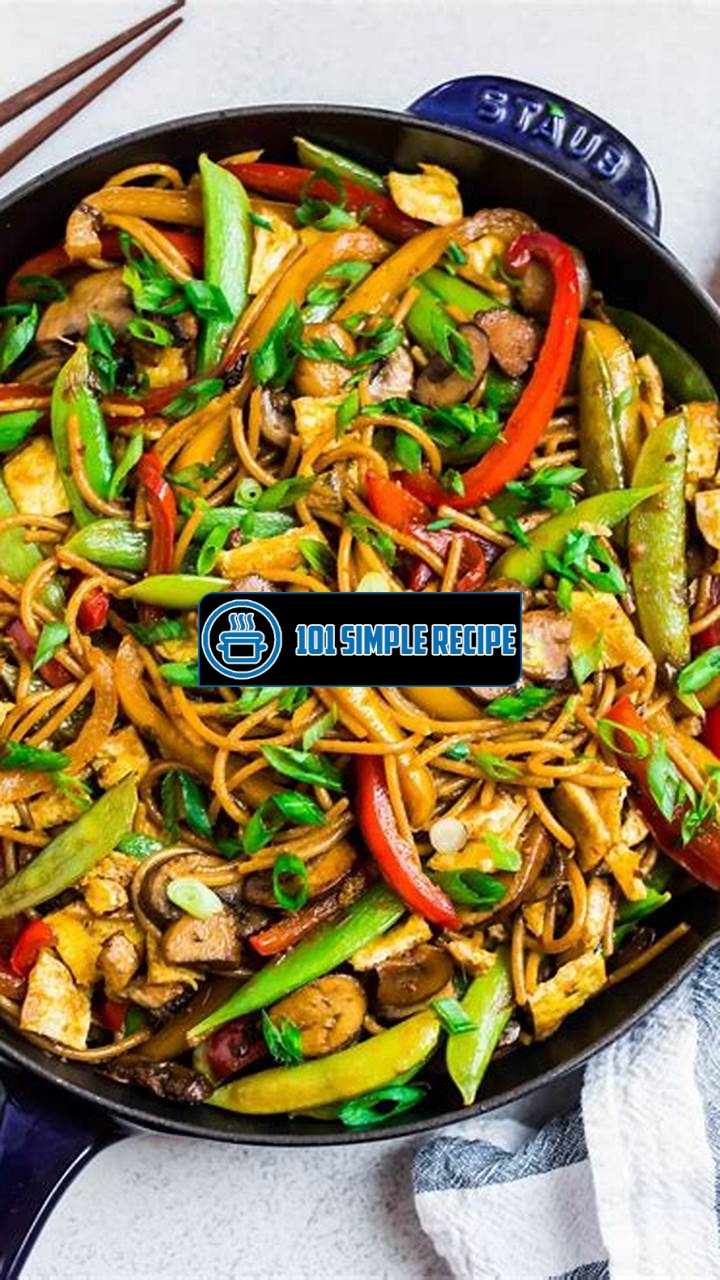Are you craving a flavorful and nutritious meal but don’t want to spend hours in the kitchen? Look no further – we have the secret recipe for making delicious, healthy Lo Mein right at your fingertips! Lo Mein, a popular Chinese dish consisting of stir-fried noodles, vegetables, and protein, is a versatile and satisfying meal that can be customized to suit your taste preferences. Whether you’re a vegetarian, a meat lover, or simply looking to incorporate more veggies into your diet, this recipe has got you covered. With our easy-to-follow steps and a few key ingredients, you’ll be able to whip up a mouthwatering plate of Lo Mein in no time. So, put on your apron and get ready to embark on a culinary adventure!

Satisfying Your Cravings with Healthy Lo Mein
Discover the delicious and nutritious world of healthy lo mein, where you can indulge in a satisfying meal without compromising your health goals. If you’re craving a comforting and flavorful dish, lo mein is the perfect choice. This Chinese noodle dish is known for its versatility and can be made with a variety of ingredients to suit your taste preferences.
What Makes Lo Mein Healthy?
Lo mein can be a healthy option if prepared with the right ingredients. Unlike other greasy and high-calorie takeout dishes, healthy lo mein is packed with nutrients and offers a balanced blend of carbohydrates, protein, and vegetables. By using whole wheat noodles or even zucchini noodles as a base, you can increase the fiber content while reducing the glycemic load. This helps to maintain stable blood sugar levels and keep you feeling satisfied for longer periods of time.
In addition, lo mein typically includes an array of colorful vegetables, such as bell peppers, broccoli, carrots, and mushrooms. These veggies provide essential vitamins, minerals, and antioxidants that support overall health. By incorporating a variety of vegetables in your lo mein, you can boost the nutrient density of your meal and add vibrant flavors.
Another factor that contributes to the healthiness of lo mein is the cooking method. Instead of deep-frying or using excessive amounts of oil, stir-frying is typically used to prepare lo mein. This technique uses minimal oil and high heat to quickly cook the ingredients, preserving their nutritional value and keeping the dish light.
Choosing the Right Noodles for Your Lo Mein
The key to a healthy lo mein lies in choosing the right type of noodles. Whole wheat noodles are an excellent option as they provide more fiber, vitamins, and minerals compared to refined white noodles. These noodles have a nuttier flavor and a chewier texture, adding depth to your dish.
If you’re looking to cut down on carbohydrates or follow a low-carb diet, you can substitute traditional noodles with zucchini noodles, also known as zoodles. Zucchini noodles are a great way to increase your vegetable intake while reducing the calorie and carbohydrate content of your lo mein.
Adding Healthy Proteins and Vegetables to Your Lo Mein
To make your lo mein a fulfilling and balanced meal, it’s essential to add healthy proteins and vegetables. Lean protein options such as chicken breast, shrimp, tofu, or even lean cuts of beef can provide the necessary amino acids while keeping the dish light and flavorful.
Incorporating an array of vegetables not only adds color and texture to your lo mein but also boosts the nutritional profile. Consider adding bell peppers, broccoli florets, snap peas, carrots, and mushrooms to your dish. These vegetables offer a range of vitamins, minerals, and antioxidants that promote optimal health and well-being.
Remember, portion control is also crucial when enjoying lo mein as part of a healthy diet. By loading up on vegetables and using moderate amounts of noodles and protein, you can create a well-balanced meal that satisfies your cravings and nourishes your body.
Now that you know the secret to making delicious and healthy lo mein, it’s time to get creative in the kitchen. Experiment with different noodle options, protein sources, and vegetable combinations to create your own unique twist on this classic Chinese dish. Enjoy the flavors, textures, and health benefits of lo mein without any guilt!
The Art of Flavorful Lo Mein Sauces
When it comes to making delicious and healthy lo mein, the sauce plays a crucial role in enhancing the flavors of the dish. The right sauce can take your lo mein to the next level, transforming it from a basic noodle dish into a culinary masterpiece. In this article, we will uncover the secrets to creating mouthwatering and healthier lo mein sauces that will tantalize your taste buds.
Healthier Alternatives to Traditional Sauce Ingredients
Traditional lo mein sauces often contain ingredients that are high in sodium, unhealthy fats, and artificial additives. However, with a few simple substitutions, you can create a healthier version of your favorite sauce without compromising on taste. Here are some healthier alternatives to traditional sauce ingredients:
- Reduced-sodium soy sauce: Swap out regular soy sauce for reduced-sodium soy sauce to minimize your sodium intake. The rich umami flavor of soy sauce will still shine through without overwhelming your dish with saltiness.
- Whole wheat noodles: Instead of using refined white noodles, opt for whole wheat noodles to increase the fiber content of your dish. Whole wheat noodles add a nutty flavor and a chewy texture that complements the sauce perfectly.
- Fresh herbs: Add a burst of fresh flavor to your sauce by incorporating chopped herbs like cilantro, basil, or mint. Not only do they add vibrant colors to your dish, but they also provide added health benefits.
DIY Lo Mein Sauce Recipes to Try at Home
If you’re looking to take your lo mein to the next level, why not try making your own sauce at home? Not only can you personalize the flavors to suit your taste preferences, but you also have full control over the ingredients used. Here are a couple of simple DIY lo mein sauce recipes to get you started:
- Sesame-Ginger Sauce: In a bowl, combine 2 tablespoons of reduced-sodium soy sauce, 1 tablespoon of sesame oil, 1 tablespoon of rice vinegar, 1 teaspoon of grated ginger, and a pinch of red pepper flakes. Mix well and drizzle over your cooked lo mein noodles for a burst of savory and tangy flavors.
- Spicy Peanut Sauce: In a blender, combine 2 tablespoons of natural peanut butter, 1 tablespoon of reduced-sodium soy sauce, 1 tablespoon of honey, 1 tablespoon of lime juice, 1 clove of minced garlic, and a pinch of cayenne pepper. Blend until smooth and toss with your cooked lo mein noodles for a creamy and spicy kick.
Balancing Flavors in Your Lo Mein Sauces
Creating a truly flavorful lo mein sauce involves striking the perfect balance between sweet, salty, sour, and umami flavors. By paying attention to the following factors, you can ensure your sauce satisfies your taste buds:
Taste and adjust: As you mix your sauce ingredients together, taste it along the way and make any necessary adjustments. If it’s too salty, add a bit of sweetness or acidity to balance it out. Don’t be afraid to experiment until you achieve the desired taste.
Using aromatics: Fragrant ingredients like garlic, ginger, and scallions can add depth and complexity to your lo mein sauce. Sauté them in oil before adding the other ingredients to infuse your sauce with their aromatic flavors.
Splash of acidity: Acidity from ingredients like rice vinegar or lime juice can brighten up your sauce and cut through the richness. Add it gradually, tasting as you go, until you achieve the right level of acidity.
With these tips in mind, you’ll be able to create a truly delicious and healthier lo mein sauce that will elevate your dish to new heights. Remember, the secret lies in experimenting with flavors, using the freshest ingredients, and striking a perfect balance. Happy cooking!
Exploring Varieties of Healthy Lo Mein
Expand your palate and explore different types of healthy lo mein dishes that cater to your specific dietary needs and preferences.
Vegan and Vegetarian Lo Mein Options
For those following a vegan or vegetarian diet, there are plenty of delicious lo mein options available that are packed with flavor and nutrients.
Instead of the traditional meat-based proteins like chicken, beef, or shrimp, vegan and vegetarian lo mein often feature plant-based alternatives such as tofu, tempeh, or seitan.
These protein substitutes absorb the flavors of the sauce and add a satisfying chewiness to the dish. They are also a great source of plant-based protein, making vegan or vegetarian lo mein a nutritious option.
To enhance the taste, try incorporating a variety of colorful vegetables like bell peppers, broccoli, carrots, and mushrooms. These veggies add a refreshing crunch and provide essential vitamins and minerals.
Gluten-free and Low-carb Lo Mein Twists
If you have gluten sensitivity or are following a low-carb diet, don’t worry – there are plenty of lo mein twists that cater to your dietary restrictions.
Gluten-free lo mein can be made by opting for gluten-free noodles made from ingredients like rice, soy, or even vegetables. These noodles have a similar texture and taste, so you can still enjoy a delicious bowl of lo mein without any adverse reactions.
For a low-carb twist, consider substituting traditional noodles with alternatives like zucchini noodles, commonly known as “zoodles.” These are made by spiralizing zucchini and can be cooked to mimic the texture of lo mein noodles.
While zucchini noodles might not be an exact match, they add a fresh and light element to the dish. You can pair them with your favorite low-carb vegetables, such as spinach, snow peas, or bean sprouts, to create a satisfying and guilt-free meal.
Authentic Regional Variations of Lo Mein
Lo mein is not only a popular dish in Chinese cuisine but also has various regional variations that offer unique flavors and textures.
Cantonese-style lo mein is one of the most well-known varieties. It features thin egg noodles, stir-fried with a combination of meats, seafood, and vegetables in a flavorful gravy-based sauce.
Northern-style lo mein, on the other hand, tends to have thicker, chewier noodles and is often cooked with a rich soy-based sauce and toppings like lamb, green onions, and cilantro.
️ Sichuan-style lo mein is known for its fiery and numbing flavors due to the inclusion of Sichuan peppercorns and spicy chili oil. It is typically served with Sichuan-style stir-fried vegetables and meats.
Exploring these regional variations of lo mein not only expands your taste buds but also provides insight into the diverse culinary traditions across different Chinese provinces.
In conclusion, whether you’re vegan, gluten-free, or simply looking to try new flavors, there are endless possibilities when it comes to healthy lo mein. By experimenting with different ingredients and regional variations, you can create a customized and nutritious lo mein dish that suits your personal preferences and dietary needs. So, get adventurous in the kitchen and start discovering the secret to making delicious and healthy lo mein!
Preparation Tips for Perfect Healthy Lo Mein
Master the art of preparing healthy lo mein at home with these expert tips and techniques.
Properly Cooked Noodles for Best Texture
Cooking the noodles to perfection is crucial for achieving the best texture in your healthy lo mein dish.
Start by bringing a pot of water to a boil. Add a generous amount of salt to the water to enhance the flavor of the noodles. Once the water is boiling, carefully add the noodles and stir gently to prevent them from sticking together. Follow the package instructions for the recommended cooking time, but be sure to taste the noodles a few minutes before that to ensure they are cooked al dente – tender with a slight bite.
Your noodles should be firm and chewy, not mushy.
Once the noodles are cooked to perfection, drain them in a colander and rinse with cold water to stop the cooking process. This will help to prevent them from becoming too soft and sticky.
Mastering the Stir-frying Technique
The stir-frying technique is essential for creating the perfect healthy lo mein dish with a satisfying mix of flavors and textures.
Start by heating a wok or a large skillet over high heat. Add a small amount of oil and swirl it around to coat the bottom of the pan. Then, add your choice of protein (such as chicken, shrimp, or tofu) and stir-fry until cooked through. Remove the protein from the pan and set it aside.
In the same pan, add a bit more oil and then toss in your favorite vegetables, such as bell peppers, carrots, and green beans. Stir-fry until the vegetables are crisp-tender, adding a splash of soy sauce or other seasonings for added flavor.
Next, return the cooked noodles and the protein back to the pan. Add the sauce of your choice, whether it’s a classic soy-based sauce or a tangy sesame-ginger one. Toss everything together gently to combine and coat the noodles and proteins with the sauce.
The key is to stir-fry quickly over high heat to prevent the noodles from becoming soggy and to maintain the freshness and crunchiness of the vegetables.
Once everything is perfectly stir-fried, remove the pan from the heat and transfer the lo mein to a serving dish.
Tasteful Garnishes to Elevate Your Lo Mein
Elevate the flavors of your healthy lo mein dish with these tasteful garnishing ideas.
Sprinkle some toasted sesame seeds or thinly sliced green onions over the top for added texture and visual appeal. Another option is to garnish with fresh cilantro or Thai basil for a burst of herbaceous flavors.
If you prefer some heat, add a drizzle of sriracha sauce or sprinkle some crushed red pepper flakes to give your lo mein a spicy kick.
Get creative with your garnishes and let your taste preferences guide you to create a personalized lo mein experience.
By following these expert tips and techniques, you can master the art of making delicious and healthy lo mein at home. Remember to cook the noodles to the right texture, stir-fry quickly and with precision, and garnish with thoughtful accents.
Pairing Your Healthy Lo Mein with Delicious Side Dishes
Enhance your lo mein experience by discovering the ideal accompaniments that complement its flavors and textures.
Healthy Vegetable Stir-fries
When it comes to pairing your healthy lo mein with side dishes, vegetable stir-fries are a fantastic choice. Not only do they add a delightful crunch and vibrant colors to your meal, but they also offer a range of health benefits. Incorporating a variety of vegetables in your stir-fry not only adds flavor and texture but also provides valuable nutrients.
Consider creating a stir-fry with broccoli, carrots, bell peppers, snap peas, and mushrooms. These vegetables are not only delicious, but they also offer a wealth of vitamins, minerals, and antioxidants. By lightly sautéing them in a flavorful sauce, you’ll create the perfect side dish that perfectly complements your healthy lo mein.
Savory Dumplings and Potstickers
Another fantastic option to pair with your healthy lo mein is savory dumplings and potstickers. These bite-sized treats are bursting with flavor and provide a satisfying contrast to the noodles. Opt for steamed or pan-fried dumplings filled with vegetables, shrimp, or lean meat for a balanced and delicious side dish.
Dumplings and potstickers not only add variety to your meal but also offer a different texture that enhances your overall dining experience. The soft dumpling wrapper contrasts with the chewy noodles, creating a delightful combination of mouthfeel. Dip them in soy sauce or a tangy dipping sauce for an extra burst of flavor. ️
Refreshing Asian Salads
If you’re looking for a lighter option to accompany your healthy lo mein, refreshing Asian salads are a perfect choice. These salads are packed with fresh vegetables, herbs, and a tangy dressing that complements the flavors of the noodles.
Consider making a traditional Chinese cabbage salad or a refreshing cucumber salad with a sesame-ginger dressing. These salads provide a satisfying crunch and a burst of freshness that balances out the richness of the lo mein. Additionally, the vibrant colors of the vegetables make the dish visually appealing.
In conclusion, when it comes to pairing your healthy lo mein with side dishes, there are plenty of options to choose from. Whether you opt for vegetable stir-fries, savory dumplings and potstickers, or refreshing Asian salads, these accompaniments will enhance your lo mein experience by providing diverse flavors, textures, and nutritional value. So, get creative and explore these delicious side dishes to elevate your next lo mein meal!
Experience the Health Benefits of Lo Mein
Are you searching for a delicious and healthy dish to include in your diet? Look no further than healthy lo mein. This popular Chinese dish not only satisfies your taste buds but also provides numerous health benefits. From balanced macronutrients to higher fiber intake and boosted vitamin and mineral levels, lo mein offers a well-rounded nutritional profile that can contribute to your overall well-being.
Balanced Macronutrients in Lo Mein
One key reason to incorporate healthy lo mein into your diet is its balanced macronutrient content. This dish typically includes a combination of protein, carbohydrates, and healthy fats. The protein component usually comes from lean meat such as chicken, beef, or shrimp, providing essential amino acids for muscle growth and repair. The carbohydrates in lo mein come from the noodles themselves, giving you a steady source of energy.
Protein-packed lean meat: Choose lean meats like chicken or shrimp to enjoy a good source of protein in your lo mein.
Energizing carbohydrates: The noodles in lo mein serve as a source of complex carbohydrates, providing sustained energy.
Healthy fats: Some variations of lo mein may include a drizzle of sesame oil, adding a touch of healthy fats to the dish.
Achieving Higher Fiber Intake through Lo Mein
Fiber is an essential component of a healthy diet, and lo mein can help you increase your daily fiber intake. Vegetables like broccoli, carrots, and bell peppers are commonly added to lo mein, adding a significant amount of dietary fiber to the dish. Including fiber-rich ingredients in your lo mein can aid in digestion, promote a feeling of fullness, and support a healthy gut.
Fiber-rich vegetables: By including vegetables like broccoli and carrots in your lo mein, you can easily increase your fiber intake.
Promotes digestion: The dietary fiber in lo mein can aid in digestion and prevent constipation.
Supports a healthy gut: Adequate fiber intake contributes to a healthy gut microbiome, which plays a vital role in overall well-being.
Boosting Vitamin and Mineral Intake with Lo Mein
Another advantage of adding healthy lo mein to your diet is the increased intake of essential vitamins and minerals. The variety of colorful vegetables found in lo mein, such as bell peppers and snow peas, are packed with beneficial nutrients. These vegetables are excellent sources of vitamins A, C, and K, as well as minerals like potassium and iron.
️ Abundant in vitamins: Colorful veggies in lo mein provide important vitamins like vitamin A, C, and K, contributing to a well-rounded diet.
Mineral-rich ingredients: The vegetables in lo mein, such as bell peppers and snow peas, offer essential minerals like potassium and iron.
Rainbow of nutrients: By including a variety of vegetables in your lo mein, you can enjoy a diverse range of vitamins and minerals, promoting optimal health.
Incorporating healthy lo mein into your diet can be a delicious way to experience the nutritional benefits it offers. Remember to choose high-quality ingredients, control portion sizes, and pair it with other nutritious foods for a well-rounded meal. So why wait? Go ahead and try out some mouthwatering and nutritious variations of lo mein today!
Thanks for taking the time to read our article on healthy lo mein! We hope you found it informative and helpful in your quest for delicious and nutritious meals. If you’re looking for more healthy recipe ideas, be sure to visit our website again later. We regularly update our content with new and exciting recipes, so there’s always something new to discover. Stay tuned and happy cooking!
Frequently Asked Questions
Here are some frequently asked questions about healthy lo mein:
| No. | Questions | Answers |
|---|---|---|
| 1. | Is lo mein a healthy dish? | Yes, lo mein can be a healthy dish when made with nutritious ingredients like whole wheat noodles and lots of vegetables. |
| 2. | Can I customize the vegetables in lo mein? | Absolutely! Feel free to add your favorite vegetables to your lo mein for a personalized touch. |
| 3. | Can I use other protein sources besides chicken in lo mein? | Certainly! You can use shrimp, tofu, beef, or even just stick with vegetables if you prefer. |
| 4. | How can I make lo mein gluten-free? | To make lo mein gluten-free, substitute regular wheat noodles with gluten-free noodles made from rice or other gluten-free grains. |
| 5. | Can I meal prep lo mein for the week? | Absolutely! Lo mein is a great dish to meal prep. Just store it in airtight containers and refrigerate for up to 4 days. Reheat before serving. |
| 6. | Is lo mein high in calories? | The calorie content of lo mein can vary depending on the ingredients used. However, by using lean protein and plenty of vegetables, you can keep the calorie count moderate. |
Closing Thoughts
We hope this article has inspired you to try making healthy lo mein at home. It’s a versatile and flavorful dish that can be easily customized to your taste preferences. By using whole wheat noodles, fresh vegetables, and lean protein, you can enjoy a satisfying and nutritious meal. Don’t forget to visit our website again for more delicious and healthy recipe ideas. Happy cooking!
Jump to Recipe
Healthy Lo Mein

A healthy and flavorful version of traditional lo mein, packed with nutritious ingredients and bursting with flavors.
- 8 oz whole wheat lo mein noodles
- 2 tbsp sesame oil
- 2 cloves garlic (minced)
- 1 tbsp minced ginger
- 1 bell pepper (sliced)
- 1 carrot (julienned)
- 1 cup snap peas
- 2 cups shredded cabbage
- 2 cups bean sprouts
- 2 tbsp low-sodium soy sauce
- 2 tbsp oyster sauce
- 1 tbsp hoisin sauce
- 2 green onions (sliced)
- Sesame seeds and cilantro for garnish
- Bring a large pot of water to a boil. Cook the noodles according to package instructions. Drain and set aside.
- In a small bowl, whisk together the low-sodium soy sauce, oyster sauce, and hoisin sauce. Set aside.
- Heat sesame oil in a large skillet or wok over medium heat. Add garlic and ginger, and cook until fragrant. Add bell pepper, carrot, snap peas, cabbage, and bean sprouts. Stir-fry for 3-4 minutes until vegetables are crisp-tender.
- Add cooked noodles to the skillet with the vegetables. Pour the prepared sauce over the noodles and vegetables. Toss everything together until well combined and heated through.
- Garnish with sliced green onions, sesame seeds, and cilantro. Serve hot and enjoy!






